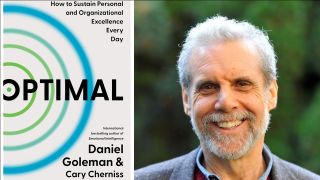Emotional Intelligence
A Review of Daniel Goleman’s New Book “Optimal"
How emotional intelligence helps you live a better life at home, work and beyond.
Posted January 9, 2024 Reviewed by Abigail Fagan

On January 9, 2024, Daniel Goleman, the internationally recognized expert on emotional intelligence, released his latest book titled Optimal: How to Sustain Personal and Organizational Excellence Every Day. Goleman’s fifth book on the topic is his first with co-author Cary Cherniss. It comes 28 years after his seminal work, Emotional Intelligence, brought this phrase into widespread use.
In this timely and practical book, Goleman and Cherniss stress the significance of emotional intelligence, painting a persuasive picture of its impact at home and at work, with actionable steps for improvement. Addressing larger issues like climate change and poverty, the authors offer a wise and hopeful approach, one that is both inspiring and compelling.
As I review Optimal, I’ll highlight tips you can use. Fair warning: They might improve your relationships, your work life, and even your community and beyond.
Part I: Optimal You
In their first two chapters, Goleman and Cherniss lay the framework for how Emotional Intelligence (EI) helps you be in an 'optimal' state, characterized by creativity, productivity, and commitment. The book offers practical strategies for creating positive, supportive, and enjoyable interactions.
Significant research on EI has been conducted since Goleman's 1995 classic, spanning various industries, organizations, and cultures across the globe. Various large studies and meta-analyses are noted and lend significant support to the value of EI for individual performance, job satisfaction, and commitment.
Real-life examples from both the lives of celebrities and everyday people are included, giving the research studies a human face. You’ll meet people like Maggie, an unfulfilled lawyer who learned how to transform her tedious job into a highly satisfying career while making millions for her organization.
Part II: The Four Quadrants of EI and How to Use Them
The four-quadrant model of EI (self-awareness, self-management, social awareness, and social implementation) is discussed in detail along with the essential competencies in each quadrant. Simplicity is one of the strengths of this model, making it easy to learn and share.
A. Self-Awareness
The most fundamental of the EI components is self-awareness. Engaging stories of success and failure illustrate this skill, ranging from Steve Jobs and Oprah Winfrey to everyday individuals like Seth, a dad stressed by the challenges of raising a newborn son.
Practical and evidence-based tips for boosting self-awareness, such as tuning into your self-talk and practicing mindfulness to improve focus and attention, are discussed with supporting evidence.
B. Self-Management
The second pillar of EI has similarities to Angela Duckworth's Grit, Carol Dweck's Growth Mindset, and Susan David's Emotional Agility, along with relevance to the pervasive topic of burnout. Specific, evidence-based strategies are offered, and will be helpful for many who are at risk of burning out.
Goleman and Cherniss remind us that “we’re not helpless; there are many ways to better handle life’s inevitable stresses.” Changing the situation when we can, adopting a more positive mindset, and making sure our bodies get the kinds of rest and recovery that spark resilience can help. Stories of Simone Biles' Olympic decision and Chris Rock's Oscar slap memorably illustrate these points.
C. Social Awareness
A big part of social awareness is about empathy. It allows us to tune into others, understand at least a bit of their thoughts and feelings, and reach out to help.
So, how can we boost our empathy? Several strategies are offered, including practicing loving kindness meditation, finding a listening ear to know how good it feels, and acting with kindness toward others. Opportunities abound in daily life when this EI quadrant is on our radar. Which one might you try today?
D. Social Implementation = Relationships
This quadrant is where the awareness components of EI come to life and touch our external relationships, both at home and at work. The story of Darcy Winslow, a leader at Nike, illustrates what is possible when people hone their skills. She deftly used her influence to spark change, ultimately resulting in a more environmentally friendly product.
A key competency in this quadrant is conflict management — vital when influencing others. It’s encouraging to know that these skills can be learned and practiced in one-on-ones and group exercises.
Bringing a mindset that views conflict as an opportunity to build something better is the first step in mending strained relationships. As Goleman and Cherniss illustrate, in some cases EI skills can transform difficult individuals into valued employees, and strained relationships into cherished ones.
Part III: EI in the Work World
Digging into the work world, Goleman and Cherniss use stories and evidence from meta-analyses to show how EI matters in the workplace, including for leaders.
So, how can a leader increase their EI? Numerous self-reflective practices are outlined, including specific techniques for active listening to help ensure others feel seen and heard. In today's world, it's become clear that leaders must possess nothing less than stellar EI skills, both for their own success and that of their organizations as well.
Robust EI skills are also essential for teams. Research, including studies at Google, highlights the many ways successful teams exhibit a high level of psychological safety and a sense of belonging. Leaders can use emotional intelligence to nurture these elements. Discussion groups and 'learning circles' offered as specific methods for developing these skills.
Guidelines for group training and fostering an EI culture are addressed in detail. Embedding EI into recruitment, hiring, performance management, and promotions can bring remarkable results, especially when supported by leaders who exemplify it. Stories from Microsoft and Amazon Web Services provide examples of companies investing in EI.
Part IV: Addressing Even Bigger Issues – and a Hopeful Path Forward
In their final chapters, Goleman and Cherniss take on even larger issues like climate change, poverty, and political corruption. They note that EI skills improve our capacity to manage emotional triggers related to these challenging topics, fostering inner calm in the process.
Importantly, EI skills are also vital for forming and sustaining the collaborations that are needed to address these complex issues.
While big problems like these can easily feel overwhelming, engaging with them — even in small ways — brings profound meaning and often a renewed sense of hope.
Goleman and Cherniss gently nudge us to aspire beyond personal happiness. They show that it's possible to sharpen our skills and align with our values to make a substantial impact, one that is urgently needed in our world.
This is a hopeful book, backed by over 300 scientific studies and authored by top experts. Read it to broaden your understanding of EI and to boost your skills — for yourself, for your community, and for the broader world.
But don't stop at reading; start living — and sharing — its message. In so doing you’ll bring hope to a world thirsting for intelligent change.
References
Goleman D, Cherniss C. Optimal: How to Sustain Personal and Organizational Excellence Every Day. HarperCollins Publishers, New York, 2024.




